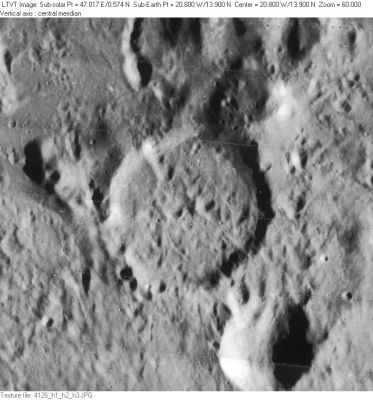Gay-Lussac
Contents
Gay-Lussac
|
Lat: 13.9°N, Long: 20.8°W, Diam: 26 km, Depth: 0.83 km, [/R%C3%BCkl%2031 Rükl: 31] |
Table of Contents

LO-IV-126H Gay-Lussac is in the center. The 15-km diameter crater to the southeast of Gay-Lussac is Gay-Lussac A. The elongated 5-km crater near the top, that looks like the head of snake, is Gay-Lussac D.
Images
LPOD Photo Gallery Lunar Orbiter Images Apollo Images
Maps
([/LAC%20zone LAC zone] 58A2) LAC map Geologic map
Description
Description: Elger
([/IAU%20Directions IAU Directions]) GAY-LUSSAC.--A very interesting ring-plain, 15 miles in diameter, situated in the midst of the Carpathian Highlands N. of [/Copernicus Copernicus], with a smaller but brighter and deeper formation (Gay-Lussac A) on the S.E. of it, and a conspicuous little crater, not more than 2 or 3 miles in diameter, between the two. The interior of Gay-Lussac is traversed by two coarse clefts, lying nearly in a meridional direction. The more westerly runs from the foot of the S. wall, near the little crater just mentioned, across the floor to the low N. border, which it apparently cuts through, and extends for some distance beyond, terminating in a great oval expansion. The other, which is not shown in the maps, is closely parallel to it, and can be traced up to the N. border, but not farther. Schmidt represents the first as a crater-row, which it probably is, as it varies considerably in width. From the S.W. side of the formation extends a long cleft, terminating at the end of a prominent spur from the S. side of the [/Montes%20Carpatus Carpathians]. There are also two remarkable rill-like valleys, commencing on the N. of Gay-Lussac A, which curve round the E. side of Gay-Lussac.
Description: Wikipedia
Additional Information
- Depth data from [/Kurt%20Fisher%20crater%20depths Kurt Fisher database]
- Arthur, 1974: 0.83 km
- Westfall, 2000: 0.83 km
- Viscardy, 1985: 0.83 km
- Cherrington, 1969: 1.7 km
- From the shadows in LO-IV-126H, the east wall of Gay-Lussac is at least 900 m tall. Gay-Lussac A is about 2,600 m deep; while Gay-Lussac D is about 910 m deep.
- Included in [/ALPO%20list%20of%20bright%20ray%20craters ALPO list of bright ray craters]
Nomenclature
Joseph Louis Gay-Lussac (December 6, 1778 - May 9, 1850) was a French chemist and physicist. He is known mostly for two laws related to gases, and for his work on alcohol-water mixtures, which led to the degrees Gay-Lussac used to measure alcoholic beverages in many countries. In 1804 he made a hot-air balloon ascent with Jean-Baptiste Biot to a height of 6.4 kilometres in an early investigation of the Earth's atmosphere. He wanted to collect sample of the air at different heights to record differences in temperature and moisture.
LPOD Articles
Bibliography
This page has been edited 1 times. The last modification was made by - tychocrater tychocrater on Jun 13, 2009 3:24 pm - afx3u2